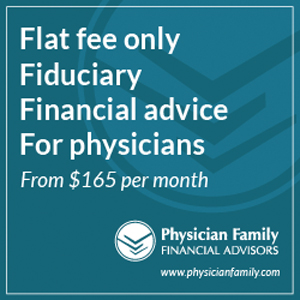When I was 25 years old and in my third year of medical school, I laid out a plan to make me financially secure and able to retire by age 50. I began by calculating an estimate of the monthly income I would need during my retirement years. I then converted that to how big my nest egg would need to be to generate that much monthly income.
Once I had that number, I used a 10% annual return on investments (which turned out to be almost exactly what my return was over the years) to calculate how much I would need to save each month to reach my goal. The monthly savings amount I calculated seemed easily attainable for an attending physician.
(Have you been putting off learning about investing in real estate? Stop procrastinating and join me at the Physician Freedom Summit 2025, October 6-8, in Los Angeles.)
I shared my figures with a professional I respected, and he told me my plan would never work. He said, “you can’t save that much money each month and therefore you will never hit that savings goal by age 50.” Apparently, he had not hit this number yet, so if he couldn’t, I couldn’t either. I checked my math and discovered that even those you respect and trust can be mistaken about the calculations. I didn’t understand why he couldn’t see it too. I never brought it up to him again.
So, I set out on my plan and was not surprised when I reached age 50 and had enough banked to retire. But, I liked my job enough to not want to retire yet. So, I continued to work at about half-time and finally pulled the trigger at age 54.
The following is the investment plan I used throughout my working years. I hope you find this example helpful.
Max out you and your spouse’s IRAs
When I finished medical school and started as a resident, I was earning an income in my first full-time job. My starting salary was just over $21k. In October I got married and my wife earned about the same amount as I did. Beginning the first year of our marriage, we both maxed out our traditional IRAs every year. (The Roth IRA would not exist for another nine years.) At that time the maximum contribution was $2,000 per person per year.
We continued to max out our IRAs for about 20 years. We stopped contributing to our IRA’s after we were investing in real estate and decided to channel the non-deductible IRA contributions into paying off our real estate mortgages instead.
Max out office retirement plans
After completing the first year of my residency, I became eligible for the hospital retirement plan. I began depositing the maximum amount allowed into this plan from every paycheck. I also tried to talk all my fellow residents into contributing to their retirement plans. All but one declined, stating they needed all their income right now and they would start retirement plan contributions when they were making the “big bucks” as an attending.
The money I deposited those four years of my residency is still in that retirement plan compounding and will likely be worth more than $1M by the time I start taking the required minimum distributions.
I became an attending at a starting salary of $100k per year and my wife chose to become a stay-at-home mom for our 1-year-old son. As soon as I met the eligibility requirements for our company retirement plan, I again began maxing out my contribution every year until I retired from the company.
Avoid personal debt
Shortly after I became a partner in my surgical practice, and my income jumped to around $200k for the rest of my years as a surgeon, my wife and I noticed we were about half a million dollars in debt. We made the decision to pay off that personal debt as quickly as possible and stay out of debt from then on. You can read about what prompted that decision and how we did it in my award-winning book, The Doctors Guide to Eliminating Debt. We have not had any house payments since 2001, eight years after becoming an attending.
Not having debt to service contributed greatly to being able to retire at age 50. Carrying debt into retirement requires saving a lot more money before retiring to spin off enough cash to make all the debt payments. Do yourself a favor and become debt free. If not now, then at least before you retire.
Own the building I worked in
The surgeons in my surgical practice owned their building. When I became a partner, I was given the opportunity of becoming an owner of the office building also. I chose to own rather than rent the building I worked in. Selling my part of the building ownership back to my partners when I retired from the practice was a nice chunk of change to kick off my retirement. Over the long run, it is almost always better to own than rent.
Invest in cash flowing real estate
When we became debt free, money was freed up each month that we were previously using to make personal debt payments. We decided we would use that money to invest in cash flowing real estate. You can get all the details on that endeavor in my best-selling book, The Doctors Guide to Real Estate Investing for Busy Professionals.
From 2001 until 2007 we purchased five small apartment buildings for a total of 65 rental units. Nine of those units that were owned with family members (one apartment complex) were later sold. You don’t need to buy a lot of real estate to create retirement cashflow. The four purchases we still own were more than enough. Since we were living on my surgical income, we poured all the profits from our real estate back into paying off the real estate mortgages. As each mortgage was paid off, our cash flow increased.
By the time I decided to retire, the real estate cashflow was greater than our living expenses.
Invest only in long-term investments
With each investment I made, I asked myself if I would be willing to own this investment for 50 years. If so, then I would buy it. My retirement funds were invested in stock mutual funds. I did not buy any bonds or keep any cash in these accounts. The only time I sold a mutual fund was when that fund was removed from the available options in my retirement plan and I was required to transfer the money to another mutual fund.
My real estate was purchased with the same long-term mentality. I plan to live off the cashflow during my retirement and leave these properties to my children upon my death. They can inherit it with a stepped up basis and sell it without having to pay any capital gains taxes. Or they can keep it and enjoy the cash flow.
Keep a budget and understand what is enough
From the beginning of our marriage, my wife and I have kept track of our income and expenses. We set up the investments listed above to pay our household bills during retirement. All the rest of our income was then available to spend as we wanted. There was no guilt in spending our remaining money on fun stuff such as a nice trip or a new RV. Since the money we were investing was already earmarked to take care of us in retirement, no additional money needed to be invested.
If one doesn’t learn this concept of “enough,” life can really be a drag. It would have been easy to say we have left over money so we should save more and invest it for the future. But we all must fight this pull. Decide what portion should be set aside for the future and live a great life on what is left. DON’T TRY TO SAVE IT ALL!
Once you strike a balance between saving and spending, life is very enjoyable. There is no guilt in spending money or giving to charity, because you know it will not hurt your future. Saving too much means missing out on life right now. Saving too little means missing out on life during retirement.
Once our investments crossed the finish line I made in medical school, we completely stopped contributing to our retirement accounts. We already had enough so we didn’t need to save more. Once we stopped contributing to our retirement accounts, my tax accountant kept telling me we could save taxes if I put money into a retirement account, but I told him we already have enough in our retirement accounts, there is no need to save more. Just because we can put more in, doesn’t mean we should.
Instead of investing more in our retirement fund or making other investments outside our retirement fund, we have channeled our extra money into fun and gifts. Once you cross your savings finish line, you can freely spend or give away all the rest. Don’t save forever.
At some point, one must switch from accumulating to spending what you have accumulated. Knowing you saved enough means you can spend the rest with a good conscious and enjoy the fruits of all that saving and preparation.
I hope my story gives you a good balanced picture of how I approached saving for retirement as I enjoyed life in the moment. Don’t go to extremes and save too much or too little. Make a good faith estimate for what needs to be saved and then enjoy the rest of your money in the moment. Life is too short to wait for retirement to enjoy yourself. Life should be lived every day.





How did you pay off your house after just 8 years?
You didn’t mention whether or not you have children, I believe this is the largest determinant of how soon one can retire.
Jo Mama,
We paid off the house using the snowball method. I detailed that journey in my book The Doctors Guide to Eliminating Debt. If you just begin making extra payments, the loan will be gone much faster than you expect.
We have two children who are grown now. They were both in college when I retired from my 20-year practice and did three years of locum work to ramp down to retirement.
Kids are not the largest determinant of how soon we can retire. Saving rate is what makes the biggest difference. Our saving rate was about 50%. We started saving half of our income when we got married and I was a first-year resident. We kept up that pattern when I became an attending. If you want to retire earlier than 70, establish a budget that incorporates a saving rate greater than 20% of your income.
Heavily skewed toward equities which worked well over the past twenty years with a few black swan events too. Takes guts to do that. It could go wrong.
Leveraging income producing (or at least positive cash flow) real estate now is hard to find with high interest rates. The markets have been giving better IRR.
Flipping the switch to retirement mode requires alot of thought about how to spend it and then sequestering investments to benefit heirs and then managing cash flow to do as much as you can handle for Roth conversions out of your IRA’s which for many of us are seriously overfunded.
A lot more to it than this author presents but the theme of save and invest and start early is fundamentally sound.
Jon,
There is no need to make things more complicated. Having 100% stock is not much different than an 80:20 portfolio, and simpler to manage. It doesn’t take guts to choose between those options.
Good real estate with a positive cash flow is not hard to find. There may be fewer than there were, but you are only looking for one. After you secure that one, then you can look for one more….
This is not high interest times. You just got used to an extended era of super low interest rates and now you feel that is the norm. Interest rates are not even back up to normal so are still low. I bought my first apartment with an interest rate of 7.75% and didn’t think it was high. In the late 70s and early 80s the interest rates were in the high teens, and even then you could by real estate and make a positive cash flow.
Switching to retirement mode does not have to be as tough as you make it out. If you are “seriously overfunded” then kick back and enjoy it. You do not need to squeeze out every penny you can to enjoy a great life. You likely don’t even need to bother with Roth conversions and will still do very well financially.
Retirement is a time to relax and enjoy the ride. Don’t worry about doing everything the most efficient way. I have loosened up my spending and I still can’t keep up with the growth of my portfolio. I have been living a nice life off my savings for eight years and my net worth is significantly higher now than when I retired. We have spent many years in the saving mode and now have to move to the spending mode.
You saved well during your working years so now relax and enjoy the ride and stop worrying about your portfolio. It is likely way more than enough.
Nice article. Dave Ramsey would approve!
Thanks for sharing this roadmap.
It worked for you.
Better yet – It still works.